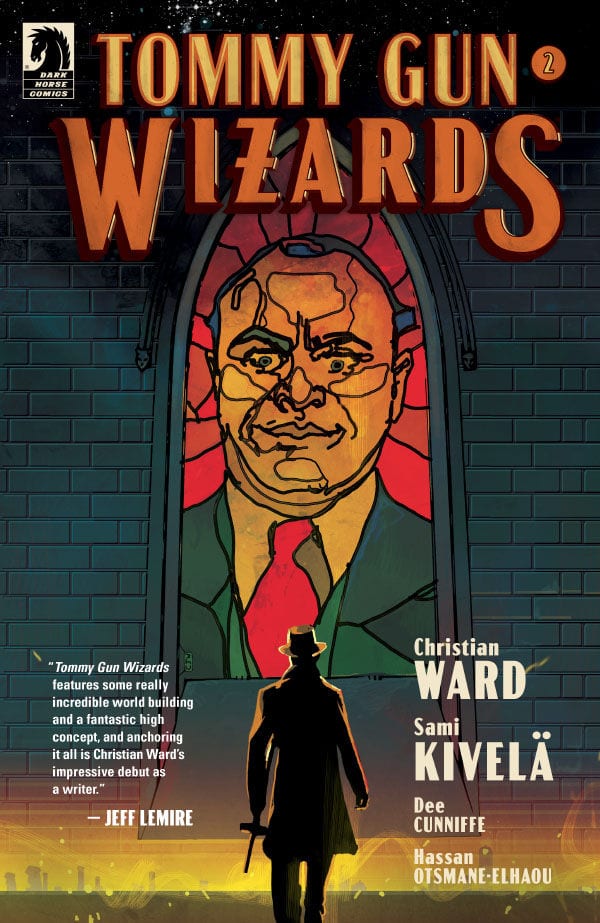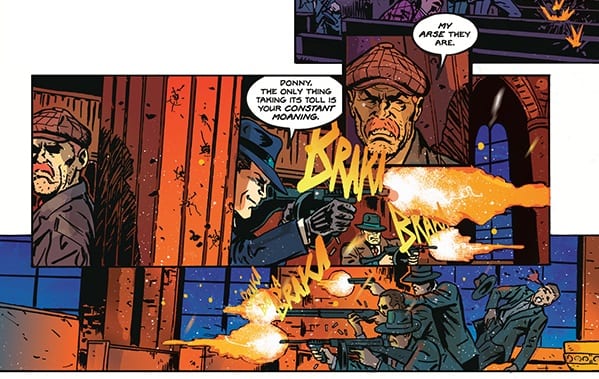A world of prohibition, Gangsters, and Al Capone isn’t enough for Christian Ward as he packs the second issue of Tommy Gun Wizards with magic, mayhem, and a rogue’s gallery fit for Dick Tracy. Dark Horse Comics bring all of this, neatly packaged, to the shelves this Wednesday.
After the scene setting first issue, Ward pushes the boat out on action, adventure and alternative historical drama. Although some of the sequences may seem a little bit ‘out there’, no-body cares because the entire creative team are clearly enjoying themselves.

Magical Scripting
The first issue of Tommy Gun Wizards was a wonderfully written drama that carefully led the reader into Ward’s world. In contrast, this second issue goes full pelt from the opening pages. Ward uses a flash back sequence to allow the reader to become better acquainted with the gorgeous Candice; get a closer look at the relationship between Elliot Ness and the underground wizards; and finally to expand on the history of the source of the magic. There is so much going on in the first four pages that you’ll need a few reads to digest it all.
Moving forward, the action hots up and Ward proves that he can write engaging fight sequences as well as character interactions. The banter between Ness’ Untouchables adds an air of lightness to the scene, creating a bombastic theatrical scene that is a joy to read.
And then Ward introduces Red and the Boys. Without giving too much away, this gang is a cross between the X-Men and Chester Gould’s greatest grotesque villains from the 1940’s. With each encounter, Ward ups the ante with a whirlwind story and several shocking moments, including a mouth dropping final page.

The Art of Wizardry
Ward gives the rest of the creative team plenty to get their teeth into. The design of the characters and the scenery is a mix of authentic 1920’s Chicago and an otherworldly fantasy almost beyond imagining. Sami Kivela brings both aesthetics together, overlaying them seamlessly to create a natural, logical world. The characters may appear to be larger than life but they fit snugly within the world of underground, black market magic facing a gang of straight laced police officers.
Kivela has a highly detailed style allowing him to cram each panel and page with massive amounts of story and character but does not overwhelm the reader. The coloring and lettering, provided by Dee Cunniffe and Hassan Otsmane-Elhaou respectively, in turn enhances the blend of magical and historic making the entire comic function with a single purpose and direction.
Cunniffe uses an array of color to create vast scenes of exuberance, such as in The Curtain Room which is an exclusive magic club. It reflects the opulence of the rich speakeasies as depicted from the early 1920’s but adds a surreal edge. Behind this he gives the scenes a color theme to represent either the action or central character being explored. This allows the reader to adjust to the change in setting and time almost subconsciously, allowing in turn Kivela to keep the story moving at the fast pace dictated by Ward’s narrative.
The lettering controls the readers flow through the panels and across the pages. Caption boxes are positioned, often in a staggered formation, to slow the reader, forcing the eye to move more around the page instead of straight across rows of panels. Otsmane-Elhaou also uses cleverly stylised fonts for some of the title/captions. These work to remind the reader of setting but also stop the reader. The titles are humorous in appearance, as if they are gently mocking the seriousness of other comics that apply similar motifs, especially superhero comics.

Conclusion
Ward enjoys merging genres and playing in multiple sand boxes at once. Tommy Gun Wizards isn’t your average noir, gangster story. It isn’t even a straight forward magical fantasy tale. Tommy Guns Wizards effortlessly blends multiple genres into an amazingly entertaining read with stunning visuals. It tells a tall tale inspired by Sunday afternoon movies and early adventure comics, and never takes itself too seriously. It mocks itself, and other such stories, in a fun, inoffensive way.
With an additional back up story entirely written and drawn by Ward, the second issue of Tommy Gun Wizards has as much, if not more, to offer than the first issue. The comic is pure escapism and a must read for anyone wanting to disappear into a magical, exhilarating world, even if it’s just for a few glorious moments.

